By Scott Smith | Contributing Editor
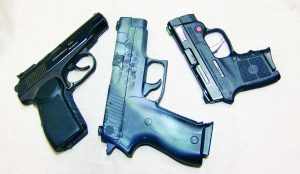
Comparative view of the Makarov (L), Sig P225 (C) and Smith & Wesson Bodyguard (R). All are compact single stack pistols.
While getting ready for the annual pilgrimage to Vegas for the SHOT Show, I was amazed with the number of compact pistol press releases I was receiving. It seems the manufacturers are again fixated on smaller “more concealable” handguns. All of this current PR reminds me of the Bill Clinton Era and the ’94 Crime Bill that limited civilian magazine capacity to ten rounds. The prevailing thought at the time was no reason for these full sized pistols if you can only load ten rounds. This led to the rise of the baby Glock, aka the Glock 26 and 27.
These two pistols became the hands-on favorite of the Crime Bill Era. Well at least for some folks. I was and still am not a fan ultra compact pistols. First off, I have big hands and these little pistols are too small to fit me comfortably. Second, small pistols and snub nose revolvers require a lot of practice to shoot well. Third, my thoughts were, if I am limited in capacity why not carry a full sized 1911? Having been issued one on active duty I was comfortable with it and that is what I chose to carry; still do today.
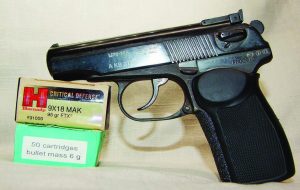
You can see the safety and slide stop of the Makarov in this photo with its test ammunition.
What I did discover during this time were a couple of pistols that were built from the ground up as compact duty weapons. These are the Sig Sauer (Phone: 603-610-3000; Online: sigsauer.com) P225 and the Soviet Makarov. When I would go to local gun shows I saw various dealers with these two pistols. With a bit of research through catalogs of wholesalers that specialized in military and law enforcement surplus firearms I found one of each.
While listed as used, the Makarov was wrapped in its original oil paper with an extra magazine and looked brand new. The P225 was one of the last production models; it was in near new condition. What I liked about both pistols and still do is their size. The grip length lies between an Officers Model and full size 1911. For me they both allow a full firing grip. That was my issue with the new baby pistols; my pinky finger, sometimes my ring finger, had no place to grip. This leads to poor marksmanship.
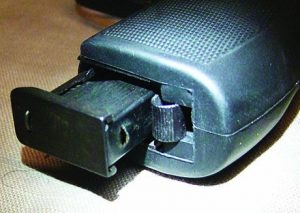
The heal magazine is not fast but the magazine locks securely every time.
The P225 is chambered in 9mm so finding quality hollow point ammunition was not an issue. At the time Federal’s 9BP 115-grain hollowpoint was the best load on the market; some will argue it still is. The 225 loved this load so that is what I loaded it with. The same cannot be said for the Makarov; back twenty years ago the only available ammunition was surplus Russian hard ball. Not ideal for personal protection, but a lot of fun to shoot. So let’s take a look at these two pistols.
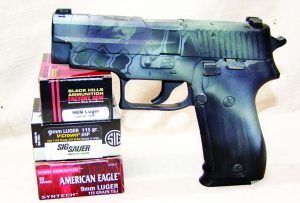
Like all Sigs, the P225 has a takedown lever, decocking lever and slide stop located on the left side of the pistol.
First up is the Makarov. My pistol is an IMEZ, built in Russia and imported by KBI which is long gone. You will also find them made by Izmash and Baikal. No matter the manufacture Maks are blow-back operated and generally chambered in 9X18; some .380ACP versions were made, but they are rare. You may also find a double stack version which is as rare as a unicorn. I have only seen two versions of a Mak, fixed rear sight or an adjustable version. Being a Russian pistol the adjustable rear sight is built like an AK47; it will survive anything. The front sight is diminutive at best.
Appearance-wise the Mak is basic; it’s black steel. There is a single side safety/decocking lever (down to fire) on the slide, slide lock and butt heal magazine release. The takedown lever is the trigger guard. If memory serves me, my pistol had rust colored polymer grips. They have long since been replaced by Pearce grips. It is 6¼” long with a 3½” barrel and is 4¾” tall. This pistol is hand-sized for me. Trigger pull is a bit over 14 pounds double action and 5-ish single. Surprisingly, from day one it was smooth with very little slack.
Initially the only ammunition I had for the Mak was 95-grain full metal jacket steel cased Russian surplus. While not ideal it was fine for range or truck gun use. A few years back Hornady introduced their FTX with a 95-grain offering for the Mak. This is now what I keep in the pistol’s eight-round magazines. From experience I know the full metal jacket ammunition is deadly, I have used it to put three deer out of their misery that have been hit by vehicles.
Accuracy-wise Makarov’s will never be a competition pistol. The barely-there front sight and heavy double action trigger kill precision accuracy. At 15 yards the best I have been able to get this pistol to shoot is 3½”.
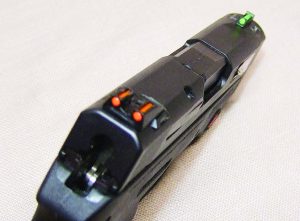
Williams Fire Sights are a great addition to the Bodyguard. They give you a functional sight picture.
I have no doubt having a real front sight installed and trigger job done would vastly improve this performance, but at what cost? My initial investment was less than $150. I cannot see putting another $300 plus in it to sit in the glove box.
Making a big move up the performance ladder is Sig’s P225. Some of the first P225s I had seen in the states were surplus Polizei and were stamped P6. Because of their rarity today, these command a premium price. Standard 225s when I found mine were selling for $350-$400; today you will find original 225s fetching $800.
The P225 looks much like its larger siblings the 229 and 226. It is a single column 8+1 9mm. Sight dovetails fit all current styles of Sig sights; I replaced the worn out Siglites with Sig’s XRay U-notch sights. With their bold green outline tritium vial and U-notch rear they are fast to acquire and accurate. What sets the 225 apart from other P series pistols is the compactness; 7” long, 6.37” tall with a 3.86’ barrel. With its 1.25” width the 225 is the slimmest of Sig’s metallic framed pistols. The takedown lever, decocking lever and slide stop are all located on the left side of the pistol with the magazine release located just behind the trigger.
What I like about the 225 is the grip is 229 sized so you get a full grip, but the slim width conceals well. The narrower grip also fits folks with small hands. Having a full length grip shooter’s accuracy is improved and felt recoil is reduced. Both are major pluses for smaller stature shooters. This slimmer design is so good, other companies are now following suit.
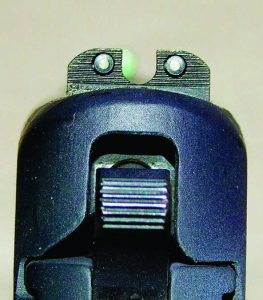
Sig’s X-ray Sights’ U- notch is large, allowing for fast front sight acquisition.
To test the 225, I stuck with standard velocity 124-grain hollow points and 115-grain full metal jacket loads from Black Hills Ammunition (Phone: 605-348-5150; Online: black-hills.com); for range and competition I chose the 115-grain Syntech from Federal (Phone: 800-379-1732; Online: federalpremium.com) and finally Sig Sauer’s 115-grain V-Crown hollow point . From the bench at 15 yards all four rounds consistently shot 2”, five- shot groups. Offhand it was easy to keep 9 rounds in the upper A/C zone of an IDPA target. This is more than acceptable accuracy for a carry handgun. I would and do trust my life with this pistol as I carry it a lot because it conceals well.
When a true pocket pistol is needed, I carry the now overlooked Smith & Wesson (Phone: 800-331-0852: Online: smithwesson.com) M&P Bodyguard 380, Crimson Trace model. I say this is an overlooked pistol because the Shield Series has received loads of media attention since they were introduced. The reasons I purchased this pistol were the price and the integral laser. When I purchased it about three years ago, it set me back about $300; today the MSRP is $449.
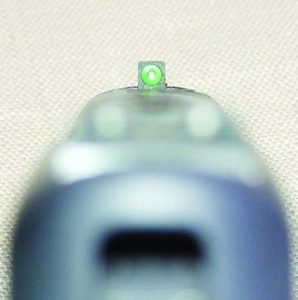
With the luminescent ring in any lighting condition, while the tritium dot of the X-rays glows at night.
While I am not a fan of lasers, having one on a small pistol is almost a requirement because the sights are abysmal. I did find a set of Williams Fire Sights (Phone: 800-530-9028; Online: williamsgunsights.com) to fit the Bodyguard. They are the best $49.95 I spent for the pistol. The other change I made was to install Galloway Precision’s (Online: gallowayprecision.com) Santiago Short Stroke Trigger Kit. This kit was installed because the factory trigger was gritty and the trigger is polymer. Galloway uses a steel trigger and hammer. This gives you a smooth consistent trigger pull and is well worth the $99.99 price tag. If you follow Galloway’s instruction videos, installing the parts is a breeze.
When I initially was shooting the Bodyguard in its stock configuration at 7 yards it was hard to keep sub 4” groups. Once I installed the Williams Fire Sights and Galloway Precision Santiago Short Stroke Trigger, groups shrank to 3” or better. Having sights you can see and a smooth trigger made a huge difference on this diminutive pistol.
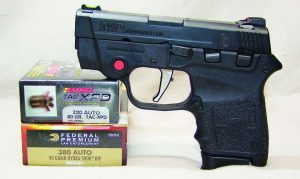
The Bodyguard has four controls: the laser, which is ambidextrous; takedown; slide stop, and rare on pocket pistols, a safety. You can also see Galloway Precision’s steel trigger.
With the new parts installed groups showed improved accuracy. When the laser was turned on you could see a marked reduction in shaking while stroking the trigger. When a pistol has as short a grip length as the Bodyguard, it is important to have this smoother trigger.
I chose Barnes Bullets’ (Phone: 435-856-1000; Online: barnesbullets.com) 80-grain TAC-XPD and Federal’s 90-grain Hydra Shok to test the Bodyguard. As previously stated the enhanced Bodyguard consistently shot sub 3” five-shot groups offhand at 7 yards. If I really took my time, it was possible to get 2” groups. Using just the laser it was easy to keep 7 shots in the upper A/C zone of an IDPA target. Out of this pocket pistol, I would call that acceptable accuracy.
`When you are looking for a compact pistol do not be afraid to look at classic pistol designs or newer ones that may not get as much media attention. Odds are you will find good deals that will suit your needs. The only thing is the pistol will not be one of the coolest on the market. No matter what you end up with, get to the range and practice with your chosen firearm. Practice will make you shoot accurately, safely and believe it or not you will have fun doing it



